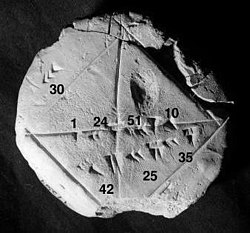Numerical analysis is the study of algorithms that use numerical approximation (as opposed to general symbolic manipulations) for the problems of mathematical analysis (as distinguished from discrete mathematics).
One of the earliest mathematical writings is the Babylonian tablet BC 7289, which gives a sexagesimal numerical approximation of  , the length of the diagonal in a unit square. Being able to compute the sides of a triangle (and hence, being able to compute square roots) is extremely important, for instance, in carpentry and construction.[2]
, the length of the diagonal in a unit square. Being able to compute the sides of a triangle (and hence, being able to compute square roots) is extremely important, for instance, in carpentry and construction.[2]
Numerical analysis continues this long tradition of practical mathematical calculations. Much like the Babylonian approximation of  , modern numerical analysis does not seek exact answers, because exact answers are often impossible to obtain in practice. Instead, much of numerical analysis is concerned with obtaining approximate solutions while maintaining reasonable bounds on errors.
, modern numerical analysis does not seek exact answers, because exact answers are often impossible to obtain in practice. Instead, much of numerical analysis is concerned with obtaining approximate solutions while maintaining reasonable bounds on errors.
Numerical analysis naturally finds applications in all fields of engineering and the physical sciences, but in the 21st century, the life sciences and even the arts have adopted elements of scientific computations. Ordinary differential equations appear in the movement of heavenly bodies (planets, stars and galaxies); optimization occurs in portfolio management; numerical linear algebra is important for data analysis; stochastic differential equations and Markov chains are essential in simulating living cells for medicine and biology.
Before the advent of modern computers numerical methods often depended on hand interpolation in large printed tables. Since the mid 20th century, computers calculate the required functions instead. The interpolation algorithms nevertheless may be used as part of the software for solving differential equations.
Software
Since the late twentieth century, most algorithms are implemented in a variety of programming languages. The Netlib repository contains various collections of software routines for numerical problems, mostly in Fortran and C. Commercial products implementing many different numerical algorithms include the IMSL and NAG libraries; a free alternative is the GNU Scientific Library.
There are several popular numerical computing applications such as MATLAB, S-PLUS, LabVIEW, and IDL as well as free and open source alternatives such as FreeMat, Scilab, GNU Octave (similar to Matlab), IT++ (a C++ library), R (similar to S-PLUS) and certain variants ofPython. Performance varies widely: while vector and matrix operations are usually fast, scalar loops may vary in speed by more than an order of magnitude.[5][6]
Many computer algebra systems such as Mathematica also benefit from the availability of arbitrary precision arithmetic which can provide more accurate results.
Also, any spreadsheet software can be used to solve simple problems relating to numerical analysis.
See also
References
- Gilat, Amos (2004). MATLAB: An Introduction with Applications (2nd edition ed.). John Wiley & Sons. ISBN 0-471-69420-7.
- Hildebrand, F. B. (1974). Introduction to Numerical Analysis (2nd edition ed.). McGraw-Hill. ISBN 0-070-28761-9.
- Leader, Jeffery J. (2004). Numerical Analysis and Scientific Computation. Addison Wesley. ISBN 0-201-73499-0.
- Trefethen, Lloyd N. (2006). "Numerical analysis", 20 pages. In: Timothy Gowers and June Barrow-Green (editors), Princeton Companion of Mathematics, Princeton University Press.











Tidak ada komentar:
Posting Komentar